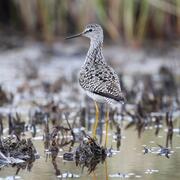Birds
Birds
Filter Total Items: 60
Tracking Data for Long-billed Curlews (Numenius americanus)
Available here are tracking data for the largest shorebird in North America, the long-billed curlew. This species nests in deserts and grasslands of central and western North America and spends the nonbreeding season in agriculture fields and pastures or along coastlines in California, Texas, and Mexico. These data were collected to better understand the migratory patterns of this unmistakable and...
Tracking Data for Buff-Breasted Sandpipers (Calidris subruficollis)
Available here are tracking data of buff-breasted sandpiper, a shorebird species that breeds only in Arctic Alaska and Canada, spending the winter in the grasslands of Brazil, Uruguay, and Argentina after a lengthy migration. These data were collected to determine range-wide migratory routes, migratory timing, and stopover habitats of this species.
Tracking Data for Long-tailed Ducks (Clangula hyemalis)
Available here are tracking data of long-tailed duck, a species of seaduck that breeds throughout the circumpolar Arctic and spends the winter in coastal areas of northern and mid latitudes. These data were collected to determine range-wide migratory routes, migratory timing, and stopover habitats of this species.
U.S. Fish and Wildlife Service Tracking Data for Lesser Yellowlegs (Tringa flavipes)
Available here are tracking data of Lesser Yellowlegs ( Tringa flavipes). These data were collected to inform the spatiotemporal migratory patterns of Lesser Yellowlegs between subarctic breeding areas in Alaska and Canada and wintering areas in South America, the Caribbean, Central America, and the contiguous United States.
Tracking Data for Bar-tailed Godwits (Limosa lapponica)
Available here are tracking data for two subspecies of Bar-tailed Godwits. One of the subspecies, Limosa lapponica baueri, nests in Alaska and spends the nonbreeding season in New Zealand and eastern Australia whereas L.l.menzbieri nests in Siberia and spends the nonbreeding season in western Australia. This study was the first to describe the year-round movements of these extremely long-distance...
Tracking Data for Red-faced Cormorants (Phalacrocorax urile)
Available here are tracking data for the red-faced cormorant, a seabird species that is found only in the North Pacific Ocean, breeding and wintering from southern Alaska and throughout the Aleutian Islands to Far Eastern Russia. These data were collected to better understand the migratory patterns of red-faced cormorants that breed in the Aleutian Islands.
Tracking Data for Spectacled Eiders (Somateria fischeri)
Available here are tracking data of Spectacled Eider, a sea duck species that breeds only in Alaska and Russia and spends the winter exclusively in the Bering Sea. The Alaska breeding population is listed as threatened under provisions of the Endangered Species Act. These data were collected to better understand the winter distribution in the Bering Sea and locate birds for winter aerial surveys...
Tracking Data for Three Large-bodied Gull Species and Hybrids (Larus spp.)
Available here are tracking data of large-bodied gull species and hybrids ( Larus species). These data were collected to better understand the migratory movements of these birds and their role in the dispersal of antibiotic resistant bacteria among areas of Alaska and other regions.
Tracking Data for Emperor Geese (Anser canagicus)
Available here are tracking data for the Emperor Goose, an endemic waterfowl species to the Bering Sea region that breeds primarily in western Alaska on the Yukon-Kuskokwim Delta and spends the winter in southwestern Alaska and throughout the Aleutian Islands. These data were collected to better understand the migratory patterns, winter habitat use, and annual survival of emperor geese.
Tracking Data for Pacific Loons (Gavia pacifica)
Available here are tracking data of Pacific Loons, a species that breeds throughout much of Alaska and winters throughout the Pacific Ocean basin, along the costs of East Asia and the U.S. These data were collected to better understand timing of spring arrival, fall departure, and habitat use patterns on the North Slope of Alaska.
Tracking Data for Greater White-fronted Geese (Anser albifrons)
Available here are tracking data of Greater White-fronted Geese, a species that nests in coastal areas of western and northern Alaska and winters across a broad area of North America along the Pacific and Central flyways. These data were collected to better understand the timing and patterns of migratory movements and seasonal use of habitats in breeding, wintering, and migratory areas of North...
Tracking Data for Surf Scoters (Melanitta perspicillata)
Available here are tracking data of Surf Scoter, a duck species that breeds throughout higher latitudes of Alaska and Canada and winters along coastal areas of North America. These data were collected to better understand the timing and patterns of migratory movements between breeding and wintering areas.













